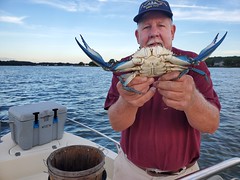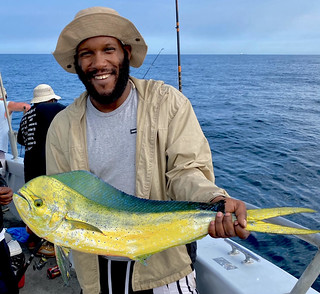Maryland Fishing Report – September 1

Trevor Vallandingham was casting in the lower Patuxent River when he got a big surprise with this cutlass fish. Photo by Bob Brown
Anyone who has thoughts of catching some Spanish mackerel ought to make a move in the next week or so. The action could hardly get any better, and looking at the calendar it probably will not. The first big blow and cold front to greet us in September will probably have the Spanish mackerel start heading south.
The Spanish mackerel along with their bluefish sidekicks are harassing schools of bay anchovies along major channel edges throughout the lower Bay. Trolling small Drone spoons and Clark spoons behind planers is a good way to work the channel edges in search of Spanish mackerel. Breaking fish can often be spotted by the presence of diving seagulls, and this is the time to break out light spinning tackle. Carefully come in upwind of the surface action and cast metal jigs or Got Cha jigs as far into the action as possible, allow the lure to sink, and retrieve as quickly as possible. Spanish mackerel are real speed demons and they’ll be able to run down fast retrieved lures. Bluefish are not as fast.
Casting a variety of soft plastic jigs or paddletails along shoreline structure with depths of 6 feet to 12 feet along the shores of the Bay and tidal rivers is a good way to target a mix of striped bass, speckled trout, and legal-sized red drum measuring 18 to 27 inches. The Tangier Sound region, the cuts through Hoopers Island, and the lower Patuxent and Potomac rivers are excellent places to fish.
Those casting lures are also catching a summer visitor to Maryland’s portion of the Chesapeake Bay. The cutlass fish, Trihiurus lepturus, which some are calling ribbonfish, are a fierce-looking fish with a mouth full of large teeth. They can grow to a length of 5 feet and are actually good to eat.
Catch and release fishing for large red drum continues to be good this week in areas near the Target Ship, the Mud Leads and near Point Lookout. Some are being caught by trolling large spoons behind inline weights, others by jigging with large soft plastics when schools can be found or by dropping soft crab baits down to fish that are spotted on a depth finder.
Cobia fishing is showing signs of slowing down as the fish seem to be heading south. There are still some being caught this week by a variety of methods. Chumming is perhaps the most popular way to fish, allowing a fresh menhaden chunk or a live eel to fall into the back of the chum slick. Trolling with rubber hose lures and large spoons is another method as is sight casting with live eels or large soft plastic lures cobia swimming near the surface. The Mud Leads near the Target Ship and Smith Point are two of the more popular places to fish this week.
Spot are getting large enough to find a place on the dinner table, and anglers are enjoying the bounty. The mouth of the Patuxent River up to the Route 4 Bridge is one of the best places to fish for them, Tangier Sound is another excellent location. White perch and small croaker are also part of the mix when bottom fishing. White perch are also being found in the tidal rivers and creeks and some are quite large. Casting beetle spins, spinners, and small jigs near shoreline structure during the quiet morning or evening hours is a fun way to fish with light tackle.
Recreational crabbing continues to move along this week at the same pace we’ve seen for weeks now. The largest crabs — and some of them are real whoppers — are coming from waters from 10 feet to 15 feet in depth. Smaller but legal-sized crabs are being caught in waters as shallow as 4 feet. Trot lines are being baited with chicken necks or razor clams, and collapsible crab traps and hand lines are baited much the same. The crabs are not as far up the tidal rivers and creeks as they were in August

Bluegills are often the first fish that youngsters catch and so it was for this happy little angler, Saoirse Kauffman. Photo by K. Kauffman
We celebrate the beginning of September, and before this month moves too far along we will most likely see some changes occur to the freshwater fishing scene due to cooler weather and rain events. It looks like we are going to receive a lot of rain from what is left of Ida later this week, so it remains to be said how this will affect stream flows.
Basically most trout management streams and rivers run low and clear this time of the year, making for a difficult approach requiring the utmost stealth. Light leaders and lines are usually a must whether, fishing for trout in streams or smallmouth bass in the upper Potomac River. The early morning and late evening hours are optimal times when fish are still active before the heat of the day.
Largemouth bass continue to hold onto a typical summer mode of behavior. Sunrise is occurring later in the morning now and it is becoming much easier to be out on the water at the crack of dawn. This is the best time to fish the shallower areas near grass with topwater poppers, frogs and chatterbaits. Lipless crankbaits, spinnerbaits and jerkbaits can be a good choice along the edges of grass and spatterdock.
As the morning hours wear on, dropping wacky rigged soft plastic worms and stick baits down through grass in deeper areas is a good tactic. Targeting deeper structure such as grass, sunken wood, or rocks with soft craw jigs, grubs or wacky rigged stick worms can entice loafing bass to strike.
Bluegill sunfish are always ready to entertain anglers of any age during the summer months. Casting small flies and rubber-legged poppers with a light weight fly rod offers plenty of fun near grass and lily pads. Casting small lures or fishing with bait under a small bobber with spinning gear is a surefire way to target bluegills also.
Northern snakeheads are on the prowl in most tidal waters within the Chesapeake watershed. The creeks that feed into the tidal Potomac, lower Dorchester County, lower Eastern Shore tidal rivers and creeks, and upper Bay area creeks and rivers are all excellent places to fish for northern snakeheads. This time of the year chatterbaits and frogs tend to get their attention, and it is always a good idea to dead stick a bobber and minnow if you can.
The summer heat has laid a heavy hand on surf fishing fortunes this week. Typically this time of the year waters get about as warm as they’re going to get, and surf species retreat to deeper and cooler water when the sun gets high in the sky. There are a mix of kingfish, spot, and croaker being caught in the morning hours on pieces of bloodworm or Fishbites. Strips of cut spot is a good choice for the small bluefish that are in the surf.
In and around the inlet and Route 50 Bridge area, anglers are casting a variety of jigs near the rocks of the jetties for striped bass and bluefish, with good success. Most of the striped bass are under the 28-inch minimum but offer plenty of fun catch-and-release action. Flounder are being caught at the inlet on traditional baits, the larger flounder are being caught on Gulp lures or by drifting live spot or finger mullet.
Flounder fishing is the top game in the back bay channels this week. The waters are clear, making for good fishing. Hopefully Tropical Depression Ida will not stir things up for the weekend. For those who can get outside of the inlet, the inshore lumps and reef sites are producing some limit catches of good sized flounder this week.
Fishing for black sea bass has been very good at the offshore wreck and reef sites. Flounder are part of the mix and a few party boats have been targeting the small dolphin that are plentiful at the 30 fathom lumps and beyond. Farther offshore the boats working the canyons are catching a mix of yellowfin tuna and dolphin, and catching and releasing white and blue marlin. Those deep-dropping are bringing blueline tilefish back to the docks.
“The life of every river sings its own song, but in most the song is long since marred by the discards of misuse.” — Aldo Leopold
Maryland Fishing Report is written and compiled by Keith Lockwood, Maryland Department of Natural Resources fisheries biologist.
Click Before You Cast is written by Tidewater Ecosystem Assessment Director Tom Parham.
This report is now available on your Amazon Echo device — just ask Alexa to “open Maryland Fishing Report.”
Legal Disclaimer:
EIN Presswire provides this news content "as is" without warranty of any kind. We do not accept any responsibility or liability for the accuracy, content, images, videos, licenses, completeness, legality, or reliability of the information contained in this article. If you have any complaints or copyright issues related to this article, kindly contact the author above.


